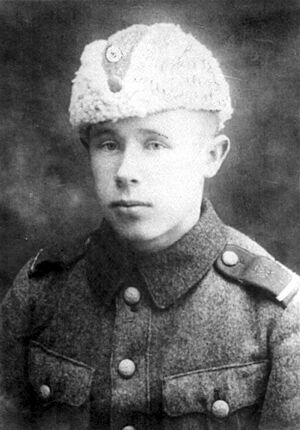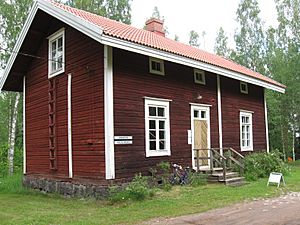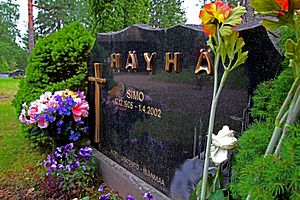Simo Häyhä facts for kids
Quick facts for kids
Simo Häyhä
|
|
|---|---|

Häyhä after being awarded the honorary rifle, model 28, on 17 February 1940
|
|
| Nickname(s) |
|
| Born | 17 December 1905 Rautjärvi, Viipuri Province, Grand Duchy of Finland, Russian Empire |
| Died | 1 April 2002 (aged 96) Hamina, Finland |
| Buried |
Ruokolahti Church graveyard
(61°17′05″N 28°49′48″E / 61.284678°N 28.829907°E) |
| Allegiance | |
| Branch | Finnish Army |
| Service years | 1925–1926, 1939–1940 |
| Rank | |
| Unit | 6th Company of Infantry Regiment 34 |
| Conflict |
|
| Awards |
|
Simo Häyhä (December 17, 1905 – April 1, 2002) was a famous Finnish military sniper. He was often called The White Death during the 1939–1940 Winter War. This war was part of World War II and was fought against the Soviet Union.
Häyhä used a Finnish-made M/28-30 rifle, which was a type of Mosin–Nagant rifle. He also used a Suomi KP/-31 submachine gun. He is believed to have killed over 500 enemy soldiers during the Winter War. This is the highest number of sniper kills in any major war. Because of this, he is often seen as the deadliest sniper ever.
Häyhä wrote a private war memoir in 1940. In it, he estimated he shot around 500 Soviet soldiers. The memoir, called War memoirs, described his experiences in the Winter War. It was hidden for many years and found in 2017.
Contents
Early Life and Joining the Army
Häyhä was born in a small village called Kiiskinen. This village was in the Rautjärvi area of southern Finland, close to the border with Russia. He was the seventh of eight children in a farming family. His parents were farmers, and Simo helped on the farm with his oldest brother. Before joining the army, he was a farmer, a hunter, and a skier.
Joining the Militia
When he was 17, Häyhä joined the Finnish volunteer militia called the Civil Guard. He was very good at shooting competitions in his area. His home was full of trophies he won for his amazing marksmanship. He was a humble person and usually stood at the back in group photos.
In 1925, at age 19, Häyhä started his 15 months of required military service. He trained in different places in Finland. He did not get special sniper training until 1938, just one year before the war.
According to Major Tapio Saarelainen, who wrote books about Häyhä, Simo could guess distances very well. He could estimate distances up to 150 meters (about 500 feet) with an accuracy of just 1 meter (3.3 feet). During his Civil Guard training, Häyhä once hit a target 16 times in one minute from 150 meters away. This was incredible for a rifle where each bullet had to be loaded by hand.
Fighting in the Winter War
Häyhä was a sniper in the Finnish Army during the 1939–1940 Winter War. He fought against the Soviet Union in very cold temperatures, sometimes as low as -40 degrees Celsius. He wore a full white camouflage suit. Soviet soldiers did not have camouflage uniforms for most of the war. This made them easy targets for snipers in the snow.
Finnish sources say that the Red Army gave Häyhä the nickname "The White Death." However, some people think this name came from Finnish propaganda. They suggest that to the Russians, "White Death" meant the severe frost in the deep forest. The name "White Death" for Häyhä became popular in Finnish books about the Winter War in the late 1980s. During the war, "The White Death" was a big part of Finnish propaganda. Newspapers often wrote about the invisible Finnish soldier, making him a legendary hero. Finns also called him "The Magic Shooter."
Häyhä's war memoir tells a story about capturing a Soviet soldier. They blindfolded him and spun him around to confuse him. Then they took him to a party in the tent of Häyhä's company leader. The Soviet soldier enjoyed the party and was sad when he was released.
His Weapons and Methods
Häyhä used his own Civil Guard rifle, a SAKO M/28-30. This rifle was a Finnish version of the Mosin–Nagant rifle. It was called "Pystykorva" because its front sight looked like the head of a spitz dog. When he fought as a group leader, he used a Suomi KP/-31 submachine gun.
Häyhä liked using iron sights on his rifle instead of telescopic sights (scopes). Iron sights meant he did not have to raise his head as much, making him a smaller target. They also worked better in extreme cold, unlike scopes which could fog up. Another problem with scopes is that sunlight can reflect off their lenses, showing the sniper's hiding spot. Häyhä had not trained with scoped rifles, so he preferred his own method.
Häyhä stayed warm in the cold by wearing many layers of clothes. He carried sugar and bread in his pockets to eat for energy. His small height (about 160 cm or 5 feet 3 inches) helped him hide easily. He would dig a snow pit and lie still, watching the enemy for a long time. He always moved to his spot before sunrise and stayed there until after sunset. He often packed snow in front of his position to hide himself. This snow also gave his rifle a steady rest and helped hide the puff of snow from the gun's muzzle blast. He was known to keep snow in his mouth while sniping. This stopped his breath from showing in the cold air and giving away his position.
Injury During Battle
On March 6, 1940, Häyhä was badly hurt. An explosive bullet fired by a Soviet soldier hit his lower left jaw. After the battle, he looked like he was dead and was placed on a pile of bodies. A fellow soldier, following orders, looked for Häyhä. He saw a leg twitching in the pile and found Häyhä alive, but unconscious. Other soldiers carried him to safety.
News spread that Häyhä had died in Finland and the Soviet Union. He woke up a week later, on March 13, the day the war ended. He read about his own death in a newspaper and sent a letter to correct the mistake. He spent 14 months getting better from his wounds and had 26 surgeries.
Häyhä wanted to fight in the next war, the Continuation War (1941–1944). However, he was not allowed to because his face was still healing from his severe injuries.
Awards and Recognition
Häyhä received several important awards. He was given the First and Second class Medals of Liberty. He also received the Third and Fourth class Crosses of Liberty. The Crosses of Liberty were usually given only to officers. As a special honor, on February 17, 1940, he received a special SAKO M/28-30 rifle. A Swedish businessman donated this rifle to him. At that time, he had shot 219 Soviet soldiers. He later gave this rifle to a museum.
Soon after the Winter War, on August 28, 1940, Finnish Field Marshal Carl Gustaf Emil Mannerheim promoted Häyhä. He went straight from a corporal (a low military rank) to a second lieutenant (an officer rank). In 1941, Häyhä was also nominated for the Mannerheim Cross. This is Finland's highest military honor. He also received a special medal for the Kollaa battle.
There is a museum called the Kollaa and Simo Häyhä Museum in Rautjärvi, Finland. It opened in 1983 and tells the story of the Battle of Kollaa. It also has a special exhibit about Simo Häyhä's life.
Life After the War
It took several years for Häyhä to recover from his injury. He had many treatments and surgeries. His face remained changed, but he otherwise recovered fully. After World War II, he was given a farm in Ruokolahti, a small town in southeastern Finland. He became a successful moose hunter and bred dogs. He enjoyed hunting, and even hunted with the President of Finland, Urho Kekkonen.
Häyhä was a modest man and never bragged about what he did in the war. He rarely talked about his experiences. In 1998, when asked how he became such a good sniper, he simply said: "Practice." In an interview in 2001, shortly before his 96th birthday, Häyhä spoke about his war experiences. He was asked if he felt bad for killing so many people. He replied, "I did what I was told to do, as well as I could. There would be no Finland unless everyone else had done the same."
Simo Häyhä spent his last years in a nursing home for war veterans. He died in 2002 at the age of 96. He was buried in his hometown of Ruokolahti. He never married and had no children.
See also
 In Spanish: Simo Häyhä para niños
In Spanish: Simo Häyhä para niños




